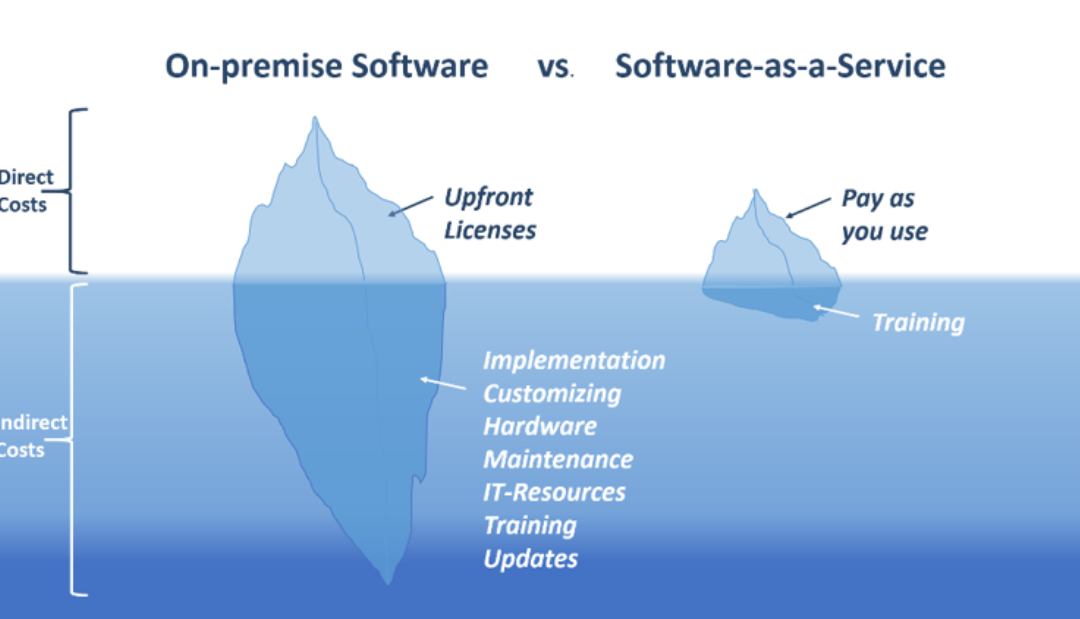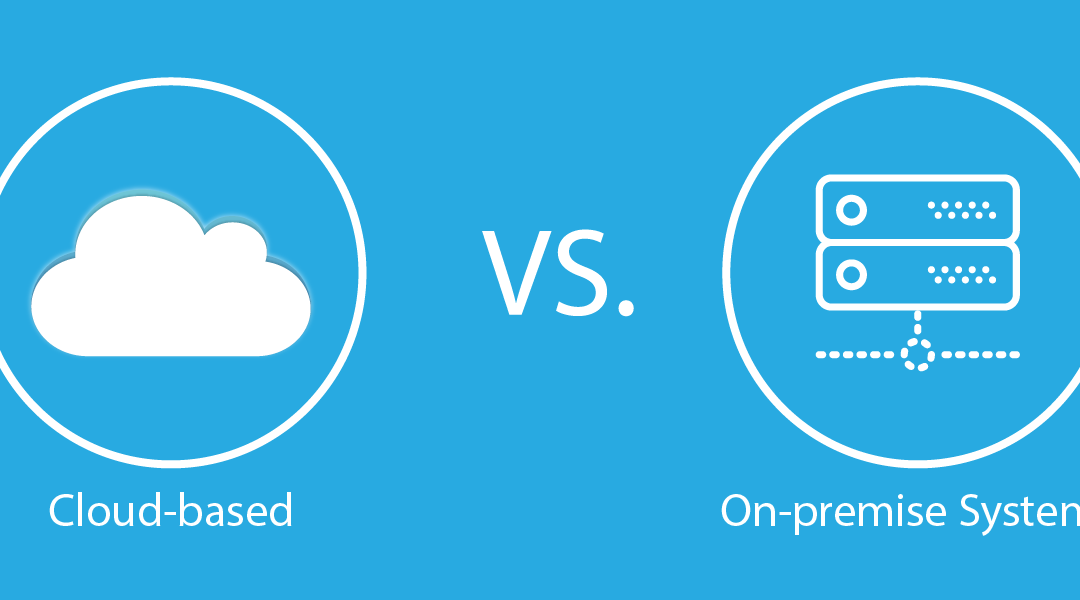
by ObiTechie's Team | May 12, 2023 | More
In today’s computing technology, companies offer numerous opportunities to improve productivity and dramatically reduce operating costs. The challenge, however, is whether to improve the on-premise solutions or completely shift to cloud-based solutions.
The whirlwind technology growth has changed how businesses manage their operations, and choosing the correct software for your needs is vital for business success. Consider several factors when deciding between cloud-based and on-premise software. This article will clearly outline the differences between the two options. We will discuss critical aspects such as scalability, cost, ease of use, and security. The information will help you make an informed decision that aligns with your business needs.
Defining On-Premise and Cloud-Based Software
On-premise Software is the traditional method of installing applications directly on a company’s servers or personal devices. The IT team then takes over maintaining and managing the software within the company premises.
Cloud-based software, on the other hand, popularly known as software as a Service (SaaS), refers to hosting applications on remote servers that third-party service providers manage. Users can only access the software online, dismissing the need to install it on personal devices or servers.
Before settling on either on-premise or cloud-based software, here are a few factors considerations you need to scrutinize:
Cost Considerations
Compared to the cloud-based option, the initial cost of implementing on-premise Software is relatively high, and you must be ready to invest in the installation fee, hardware, and licenses. Besides, the business carries the burden of ongoing on-premise software costs because they will need updates, support, and maintenance.
Conversely, cloud-based Software functions typically on a subscription basis, translating to lower initial costs. Instead of purchasing hardware and licenses, your business will pay an annual or monthly fee based on the number of users or the overall usage, and the subscription fee usually includes maintenance and support, lowering cloud-based software costs.
Security and Compliance
One of the crucial considerations when choosing software is security. For the on-premise software, businesses have complete control of their data and can take any security measures possible. This option is advantageous if your business is strict with data protection or you want to implement customized security protocols.
Maintaining a high level of on-premise software security requires dedicated IT resources which can be time-consuming and costly.
With cloud-based software security, the responsibility lies entirely with the service provider. Even with service providers investing heavily in robust precautions to ensure the safety of customers’ sensitive information, businesses still have concerns about trusting a third party for their data security.
In compliance matters, cloud-based software providers typically follow strict industry-specific rules, but the business must confirm before settling on a service provider.
Scalability and Flexibility
On-premise Software is often challenging to scale as the business advances. You must always purchase additional software and hardware to expand storage or processing capabilities. As the business grows, you must also increase IT personnel to support on-premise software scalability.
On the contrary, cloud-based software is by far more flexible and scalable. As your business expands, you can easily and quickly adjust your subscription to accommodate more data, user access, and processing power. With cloud-based software scalability, you will effectively respond to business growth and avoid outgrowing your software option.
Accessibility and Collaboration
Usually, on-premise software accessibility is limited. Users must use the company network or Virtual Private Network (VPN) to access the software, which defines collaboration and remote work.
Cloud-based software accessibility is much more enhanced compared to on-premise Software. Users can access the software from different locations if connected to the internet. Workers can easily collaborate and work remotely anytime, increasing productivity.
Updates and Maintenance
The on-premise software updates are the responsibility of the organization’s IT team. The process can be time-consuming and often requires regular downtime for system updates. Besides, organizations must set aside resources to ensure the software remains secure and up-to-date.
The service provider handles cloud-based software updates and maintenance. The service providers ensure prompt implementation of security patches and the latest features. Therefore, the burden on the IT team and downtime associated with effecting updates is limited.
Data Ownership and Control
Businesses have complete control over their data when they use
On-premise software due to storage of data in the infrastructure within their premise. On-premise software is excellent if your business is strict on data management regulatory or policy requirements.
As much as cloud-based software has rigid data privacy and security policies, organizations are only somewhat comfortable with third parties owning and controlling their data. To be clear on your cloud-based software data ownership, it is vital to closely review your service provider’s agreements and understand how they will manage, protect and store your data.
Making an Informed Decision
In conclusion, your business-specific needs will help determine whether you can settle with cloud-based or on-premise software. Although on-premise Software provides greater customization and control, it may require high initial cost and ongoing maintenance. On the other hand, Cloud-based Software offers lower initial costs, accessibility, and scalability, making it more suitable for many organizations.
By closely examining the abovementioned factors, you can make a clear decision that matches your business objectives and long time prosperity. Even with your choice, staying ahead of the current development in software technology and the best practices in the industry will help your business remain competitive in the market.
Article Source
Software as a Service (SaaS): Definition and Examples (investopedia.com)
What is Cloud Computing? Pros and Cons of Different Types of Services (investopedia.com)
Cloud Versus On Premises: Advantages And Disadvantages Of Both Models (forbes.com)

by ObiTechie's Team | May 9, 2023 | More
As we explore the 21st century, how we execute our businesses and technology are evolving and improving daily. As companies advance and develop in this digital era, the need for reliable and efficient systems to manage their operations and information is becoming more critical. Fortunately, there are two popular solutions – cloud-based and on-premise systems.
This article will deeply examine the pros and cons of each type of system to help you decide on the right path for your business. We will take you through the critical aspects of the two system types, including cost, security, scalability, and accessibility, to help you understand the differences between on-premise and cloud-based systems.
Understanding On-Premise and Cloud-Based Systems
On-premise systems are the conventional approach where businesses store their hardware, data, and software within their physical premise. The system includes storage devices, servers, and other networking equipment, and the company is entirely responsible for maintaining, securing, and managing all these resources.
On the other hand, cloud-based systems provide varying solutions as they store applications and data in a remote location, and a third-party service provider manages them. With this system, businesses don’t need physical hardware; they can access their software and data online.
Beyond the physical differences between on-premise and cloud-based systems, there are more differences between the two systems.
Cost Comparison
Considering the initial investment needed for each design is paramount when comparing the two systems’ costs. Typically, on-premise systems require higher upfront costs, and businesses must purchase infrastructure, hardware, and software licenses. In addition, they incur installation and setup costs.
On the contrary, cloud-based systems require a lower initial investment. Generally, they operate on subscription plans. In addition, the installation and setup usually are faster, and the hardware costs are negligible.
As time goes by, both systems need ongoing expenses. On-premise systems require regular maintenance, software updates, energy costs, and hardware replacements. The costs can be significant, especially for a small business.
Cloud-based solutions, on the other hand, usually have predictable monthly fees covering updates and maintenance. Since a third party executes these tasks, businesses can use the resources differently, saving money and time.
Scalability and Flexibility
Often, on-premise solutions are limited in terms of scalability. For seamless growth for on-premise scalability, businesses may require additional personnel, infrastructure, and hardware, which can be expensive and time-consuming.
Cloud-based solutions offer better scalability and flexibility. As your business advances, you can adjust your payment plans to accommodate increased user access, storage, and processing power. You will therefore allow a more agile dimension to growth, reducing the risk of outgrowing your system yet improving cloud-based scalability.
Security and Compliance
Security is a critical concern for every single business. The business is entirely responsible for all data and hardware security with on-premise solutions. The advantage is that the company can control all information and adopt customized security measures without restrictions to achieve optimum on-premise security. Even so, the business must allocate enough resources to security tasks such as patching, responding to threats, and monitoring.
Cloud-based systems depend on third parties for security. Reputable vendors invest heavily to ensure the safety of their infrastructure. Besides, they adopt standard industry practices to protect their customers’ data. Even though the vendors can offer high-level cloud-based security, some businesses hesitate to entrust a third party with their data security.
Before you decide on the best solution for your business, it is vital to consider compliance. Cloud-based solutions mostly meet industry-specific standards, but every business must verify the requirements before settling on a service provider.
Accessibility and Collaboration
On-premise solutions have limited accessibility. Typically, users must physically be at the business’s location to access the system. The requirement minimizes collaboration, making it difficult for people in different areas to access essential resources, which is a drawback for on-premises accessibility.
On the other hand, cloud-based solutions offer greater accessibility. Users can access applications and data from any location connected to the Internet. Adequate cloud-based accessibility allows better collaboration and enables employees to work remotely yet maintain productivity.
Disaster Recovery and Business Continuity
System failure, fire, or on-premise disaster recovery can be difficult in disasters like natural calamities. The systems can be at risk of data loss and extended downtime. Businesses must invest in solid backup and recovery solutions for business continuity.
Generally, cloud-based systems have built-in disaster recovery mechanisms. The system automatically stores data in multiple servers and locations, which improves disaster recovery capabilities for cloud-based applications. Automatic data storage reduces the chances of data loss and ensures faster data recovery in a disaster.
Making the Right Choice for Your Business
Finally, before settling on an on-premise or cloud-based system, you must consider your business’s priorities, needs, and resources. Consider all the above-discussed points, which will help you meet your business goals.
In conclusion, on-premise solutions are unique and offer great data control. However, they require significant initial and ongoing investment costs. Cloud-based systems provide flexibility, lower upfront costs, and scalability, making them an excellent choice for many businesses. Once you study your business’s specific needs and consider the benefits of each system, choose the one that will support your business goals and long-term strategy.

by ObiTechie's Team | May 5, 2023 | CRM Software, Marketing
Email communication is a crucial aspect of business communication; it is a powerful tool businesses use to engage with their customers. Most companies are using email communication (known as Email Marketing) to raise awareness and promote new products or services to customers. This type of digital marketing allows businesses to simultaneously reach many potential customers who subscribe to their email lists. In this article, we’ll explore its benefits to small businesses.
What Is Email Marketing?
Email marketing is when a company or business uses email to engage and communicate with customers. Businesses use this form of communication to pass critical information to customers, promote specific services and products, and increase brand awareness.
Email marketing is on the list of the oldest forms of digital marketing, yet always relevant since it is relatively easy to execute and maintain.
Email marketing has these five elements at its core:
- Consistently sending relevant information: Email marketing helps small businesses provide value for their customers by consistently sending engaging and relevant information to them.
- Building an email contact list: Email marketing will help you gain email subscribers through online or in-person sales through trial subscriptions, webinars, free e-books, and coupons that you can conveniently share through email.
- Segmenting your email list: It is essential to organize your email subscribers into segments based on items purchased, location, interests, and blog or website interactions.
- Maintaining a solid emailing list: Email marketing will help you eliminate email addresses that do not open your messages regularly and those that are never delivered, improving your email delivery rate.
- Measuring email campaign results: Email marketing helps track email open and click-through rates to help improve outcomes.
Popular Email Marketing Software
Mailchimp
Constant Contact
AWeber
Campaign Monitor
GetResponse
HubSpot
ActiveCampaign
ConvertKit
Drip
Sendinbluehttps
Benchmark
MailerLite
SendGrid
Zoho Campaigns
Infusionsoft
Benefits of Email Marketing
The following are the primary benefits you will leap from email marketing:
Increased Brand Awareness
There is always a significant chance that only some people know about your products and services. Taking a proactive approach will always help you with brand awareness. Email marketing will enhance the exposure of all your services and products. Besides, it will build the visibility you need effectively. Sending frequent emails to your subscribers and sharing newsletters, offers, promotions, and other updates will increase brand awareness.
Cost-effective
Cost-effectiveness is among the top benefits of email marketing, and Email marketing does not require incurring costs like those you would incur with TV and print media advertisements. Besides, email marketing software is now available for small businesses that will help you create and send professional emails to subscribers without investing anything. Alternatively, companies can focus on specific groups of people to minimize their expenses yet improve their return on investment (ROI).
Increased Sales and Revenue
Email marketing can be effective in encouraging impulse buying. Email marketing is a tool for generating and boosting business sales and revenue. By sharing offers, discounts, and promotions with your email list and subscribers, you will encourage them to utilize the available offers and make purchases. Email marketing will also help follow up on abandoned carts and improve conversion rates.
Personalization
Email marketing will help you personalize emails for each subscriber. You will only need to collect data on each subscriber’s behavior and preferences to customize your emails to their interests and needs. Such personalized emails will strengthen your relationship with your subscribers, improving their chances of purchasing your products and services. Your subscribers will also feel valued and appreciated, especially when you start addressing them by their names and sending them personalized offers.
Increased Website Traffic
Showcasing items frequently bought together to your customers will motivate them to visit your website more. In addition, you can offer them similar products to what they have already purchased and special discounts for future purchases. You will appreciate the number of people visiting your site to view available items.
Moreover, include relevant links within your email content. Provide your audience with extra relevant information available on your website. Also, have social media sharing buttons to encourage sharing and promoting your website information, giving your brand an extra organic reach.
Measurable Results
Email marketing is an essential tool for measuring results. The software provides valuable and precise metrics and data beyond percentages and numbers. You will use the data to customize your strategy towards the following campaigns and topics of interest, confirming that your website content is relevant to your audience and resonates with the readers.
Monitoring your open and click-through cases can give you valuable insights into the number of customers interested in your content and brand. However, it would help if you worked towards converting these interested audiences into genuine customers; the analytics will help you.
Conclusion
Overall, email marketing is a powerful tool for small businesses with many benefits. The tool helps to increase brand awareness, cost-effectiveness, increase sales and revenue, personalization, increase website traffic and enhance measurable results. The way forward for small businesses is to implement an effective email marketing strategy to reach their target audience to improve sales, build customer loyalty, and strengthen relationships.

by ObiTechie's Team | May 2, 2023 | News & Trends
Great news! Keap has officially launched its new email builder in the Campaign Builder for Max Classic. Additionally, the email builder will soon be accessible when sending email broadcasts in Max Classic. This new feature is expected to improve the user experience while creating and sending official emails. The email builder is available in the keap Max Classic, Max, and Pro.
The Features of the New Keap Email Builder
The following are the fantastic features you will enjoy with the new email builder:
Large Template Selection
The new keap email builder has a broad range of pre-designed templates for users. However, you can still create the template you want to use from scratch. If you are in a rush and want to create and send an official email without creating a design that may take you much time, this feature will meet your needs.
Multi-Column Support to Customize Your Template
The newly launched keap email builder provides multi-column support. The feature allows you to design custom layouts for your emails quickly. This feature is perfect for using more complex email designs, including multiple sections.
A Text-Only Section
Sometimes, the emails we want to send out only require a few functions. Sometimes all we need is to write text and nothing more. Keap has a text-only feature in their new email builder that you can use to create and send a straightforward message with only the text you want to convey. If you want to send out plain text emails that are easy to read and comprehend and are not likely to land in the spam box, the feature will save your day.
A New File Download Button
Do you want to include downloadable files in your next email? You need not worry because the new keap email builder can support the function. If you want your email recipient to receive additional resources or supportive information in file formats, you can do that conveniently.
A Countdown Timer
Is yours a promotion email announcing limited-time sales or offers? The new email builder has a countdown timer to depict your recipient’s urgency.
Desktop View or Toggle Mobile
The newly launched keap email builder lets you conveniently switch between mobile design and desktop modes. The feature also ensures that your emails are optimized for mobile devices and appear incredible on any device.
Improved Image Library
You can now use any image you desire in your professional emails. Whether you want to use the free professional stock images or upload and manage photos from your device, the new email builder will support the function. You will quickly and conveniently find and attach professional-quality photos to your emails. The process is timely and an excellent time-saver because the users will no longer have to omit visuals that may interest their recipients. Besides, they will not have to spend much time searching for images.
Are you ready to start building those stunning professional emails? Visit Keap’s website and discover all the features mentioned above.

by ObiTechie's Team | Apr 28, 2023 | FinTech
Cryptocurrency is a form of digital or virtual currency. Cryptographic systems secure the coins, and people can use these systems to make safe online transactions without an intermediary. No country or government authorities regulate Cryptocurrencies; therefore, governments don’t intervene in Cryptocurrency transactions. According to Blockchain technology, most of the cryptocurrencies in use are decentralized networks.
FAQ Knowledge base Support team Logout from plugin
People buy Cryptocurrencies from Cryptocurrency exchanges, mine them, or receive them as a reward for completing tasks on the Blockchain. However, not every e-commerce permit purchases using Cryptocurrencies, and you will hardly see any retail business allowing payments using Cryptocurrency, not even the popular ones like Bitcoin. Nonetheless, Cryptocurrency values have made Bitcoins popular as investing and trading instruments. Although some countries may not accept it, people sometimes use Bitcoins for cross-border transfers
The Rise of Cryptocurrency
Cryptocurrency shifted from an academic concept to a virtual reality in 2009 after the creation of Bitcoin. While Bitcoin saw a mass, consistent following in the subsequent years, it also caught the attention of investors and media in April 2013, when it recorded its highest of $266 per Bitcoin after surging ten times in the preceding two months.
Bitcoin recorded a market value of more than $2 billion at its highest. However, it also recorded a 50% plunge shortly after, which sparked a hot debate about the sustainability of Cryptocurrencies in general and Bitcoin specifically.
The Cryptocurrency market has recorded notable positivity because of the simplified microeconomic activities, which have increased the crypto price. Besides, the current trading volume of the Crypto market has risen to the highest mark since June 2021. The daily market volume is approaching $70 billion, while the Crypto market capitalization is $1.20 trillion.
Impact of Cryptocurrency on the Financial Industry
As a part of Cryptocurrency, Bitcoin can potentially dismantle a banking system. The main impacts Cryptocurrency has on the financial industry are:
• Cryptocurrency eliminates double spending. Each Bitcoin is unique, and cryptographically protected. The currency cannot be replicated or hacked. Therefore, you can neither spend the Bitcoin twice nor have it counterfeit. These features are making it more and more attractive in the financial industry.
• Even if the Bitcoin network is decentralized, it is still trustworthy.
• Bitcoin has such a strong network that it makes centralized infrastructure unnecessary. The currency is produced and distributed through a streamlined process.
Challenges and Future of Cryptocurrency
Some economic analysts are already predicting significant changes in the Crypto market as institutional money enters the market. Furthermore, Crypto will likely be floated on the Nasdaq, increasing the Blockchain’s credibility as an alternative to conventional currencies. According to some experts, investing in Bitcoin would be made easier with the availability of a verified exchange-traded fund specifically for cryptocurrencies. However, investors will still be concerned about investing in such digital assets, even if the exchange-trade fund is created, due to the lack of understanding of Crypto; this means the desire will automatically arise.
If you wish to invest in Cryptocurrency, use the same process when considering any other speculative investment. There is always risk of losing some or all your investment, and Cryptocurrency has no permanent benefit apart from what a buyer will pay when a case arises. The currency is susceptible to price swings increasing the chances of loss to an investor.
Some of the challenges Cryptocurrencies are facing:
• A computer crash or hackers ransacking a virtual vault can delete one’s digital fortune. Unfortunately, the current technology has not been able to counter such instances.
• The more popular the Cryptocurrencies become, the more likely they are to face government regulations and scrutiny, which may wear down the fundamental premise of their existence.
• Cryptocurrencies are for the technically adept. Most businesses have embraced Cryptocurrency but still need to work on increasing consumer acceptance.
• Cryptocurrency will likely be highly regulated in the coming years, which may give way to alternative currencies. Cryptocurrency must be mathematically complex to prevent hackers from accessing the systems, yet easy for consumers to understand. Crypto needs to be decentralized but with adequate protection and anonymity without being a means to evade tax, money laundering, and other notorious activities.
Conclusion
The rise of Bitcoin has led to a debate concerning its future with other Cryptocurrencies. Although Bitcoin has faced diverse issues, its success since its launch in 2009 has led to the creation of alternative Cryptocurrencies such as Ripple, Ethereum, and Litecoin. Therefore, Cryptocurrency will need to satisfy wildly divergent criteria and overcome its challenges to attract more investors and maintain credibility with the current users.
Article Source:
What the future holds for cryptocurrencies | World Economic Forum (weforum.org)
The Rise of Cryptocurrency and its Impact on the Financial Industry (fidomoney.com)
Where Is the Cryptocurrency Industry Headed in 2021? (investopedia.com)





